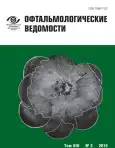Сomputed tomography anatomy of the orbital apex
- Authors: Yatsenko O.Y.1
-
Affiliations:
- Russian Medical Academy of Postgraduate Education
- Issue: Vol 8, No 2 (2015)
- Pages: 28-34
- Section: Articles
- Submitted: 24.06.2015
- Published: 15.06.2015
- URL: https://journals.eco-vector.com/ov/article/view/373
- DOI: https://doi.org/10.17816/OV2015228-34
- ID: 373
Cite item
Full Text
Abstract
The apex of the bony orbit and its soft tissues are most difficult to investigate. Meanwhile just pathological processes in this area cause several serious conditions which could lead to blindness and in many cases to disability. Purpose: to study linear and volume indices of the bony orbital apex and its soft content in normal conditions. Material and methods: 210 patients (266 orbits) are examined. Both orbits were investigated in 56 patients (112 orbits) with no orbital pathology. In patients with unilateral orbital involvement, the normal orbit was investigated (154 orbits). Among examined patients, 86 were men and 124 women. Mean age was 41.2 ± 10.4 years. The CT scan according to the standard technique obtaining axial and frontal sections was carried out in all patients (section thickness was 1.0 mm; interval - 1.0 mm). Results and discussions: The average horizontal size of the external part of an orbit in men was 22.2 ± 0.41 mm (range 17-28 mm). The same size in women was 21.4 ± 0.23 mm (17-26 mm). The vertical size of the external part of the orbit in men is equal to 23.12 ± 0.38 mm, in average and at women - 23.4 ± 0.31 mm. Orbital apex length is 16-24 mm (average 20.1 ± 0.47 mm) in men, in women it is 15-23 mm (average 19,2 ± 0,35 mm). In the article, normal volume of the orbital apex, of the optic nerve, extraocular muscles and orbital fat are presented. Ratios of volume characteristics of studied structures of the orbital apex are displayed. Conclusions: Volume characteristics of the orbital apex and its soft content could be useful to understand the pathogenesis of pathological processes in this area. They could be also used to carry out the differential diagnosis between true and false proptosis, and for surgery planning.
About the authors
Oleg Yur’yevich Yatsenko
Russian Medical Academy of Postgraduate Education
Email: olegyatsenko@rambler.ru
doctor of medical science.
References
- Wichmann W., Muller-Forell W. Anatomy of the visual system. Eur. J. Radiol. 2004; 49 (1): 8-30.
- Aviv R. I., Casselman J. Orbital imaging: Part 1. Normal anatomy. Clin. Radiol. 2005; 60 (3): 279-87.
- Chan L. L., Tan H. E., Fook-Chong S., Teo T. H., Lim L. H., Seah L. L. Graves ophthalmopathy: the bony orbit in optic neuropathy, its apical angular capacity, and impact on prediction of risk. Am. J. Neuroradiol. 2009; 30 (3): 597-602.
- Бровкина А. Ф., Кармазановский Г. Г., Яценко О. Ю. Объем костной орбиты и ее мягкотканного содержимого в норме. Медицинская визуализация. 2006; 6: 94-8.
- Бровкина А. Ф., Яценко О. Ю., Аубакирова А. С. Компьютерно-томографическая анатомия орбиты с позиции клинициста. Вестник офтальмологии. 2008; 1: 11-4.
- Lee J. M., Lee H., Park M., Lee T. E., Lee Y. H., Baek S. The volumetric change of orbital fat with age in Asians. Ann. Plast. Surg. 2011; 66 (2): 192-5.
- Malhotra A., Minja F. J., Crum A., Burrowes D. Ocular anatomy and cross-sectional imaging of the eye Semin. Ultrasound. CT MR. 2011; 32 (1): 2-13.
- Омарова С. М., Вальский В. В., Тишкова А. П. Соотношение объема орбиты и глаза у детей в возрасте от 1 месяца до 18 лет Современные технологии в дифференциальной диагностике и лечении внутриглазных опухолей. Москва. 2007; 295-301.
- Regensburg N. I., Wiersinga W. M., Berendschot T. T., Saeed P., Mourits M. P. Densities of orbital fat and extraocular muscles in graves orbitopathy patients and controls Ophthal. Plast. Reconstr. Surg. 2011; 27 (4): 236-40.
- Бровкина А. Ф., Яценко О. Ю., Аубакирова А. С. КТ - признаки изменений экстраокулярных мышц при эндокринной офтальмопатии. Вестник офтальмологии. 2006.; 6: 17-20.
- Ji Y., Qian Z., Dong Y., Zhou H., Fan X. Quantitative morphometry of the orbit in Chinese adults based on a three-dimensional reconstruction method J. Anat. 2010; 217 (5): 501-6.
- Furuta M. Measurement of orbital volume by computed tomography: especially on the growth of the orbit Jpn. J. Ophthalmol. 2001; 45 (6): 600-6.
- Kamer L., Noser H., Schramm A., Hammer B., Kirsch E. Anatomy-based surgical concepts for individualized orbital decompression surgery in graves orbitopathy. I. Orbital size and geometry Ophthal. Plast. Reconstr. Surg. 2010; 26 (5): 348-52.
- Вальский В. В., Пантелеева О. Г., Тишкова А. П., Бережнова С. Г. Клинико. Томографические признаки различных форм эндокринной офтальмопатии. Научно-практическая конференция сахарный диабет и глаз. Москва, 29-30 сентября, 2006; 300-3.
- Giaconi J. A., Kazim M., Rho T., Pfaff C. CT scan evidence of dysthyroid optic neuropathy Ophthal. Plast. Reconstr. Surg. 2002; 18 (3): 177-82.
- Kashkouli M. B., Imani M., Tarassoly K., Kadivar M. Multiple cavernous hemangiomas presenting as orbital apex syndrome. Ophthal. Plast. Reconstr. Surg. 2005; 21 (6): 61-3.
- Николаенко В. П., Астахов Ю. С. Орбитальные переломы. Руководство для врачей СПб.: Эко-Вектор. 2012; 436.
- Бровкина А. Ф., Кармазановский Г. Г., Яценко О. Ю., Мослехи Ш. Состояние зрительного нерва при отечном экзофтальме, осложненном оптической нейропатией (данные КТ исследований). Медицинская визуализация. 2008; 3: 74 -7.
- Яценко О. Ю. Объемно-топографические и структурные изменения мягких тканей вершины орбиты при оптической нейропатии у пациентов с отечным экзофтальмом. Офтальмология. 2014; 2: 48-54.
- Kapur E., Dilberovic F. Computed tomography review of the osseous structures of the orbital apex Bosn. J. Basic. Med. Sci. 2003; 3 (3): 50-53.
Supplementary files









